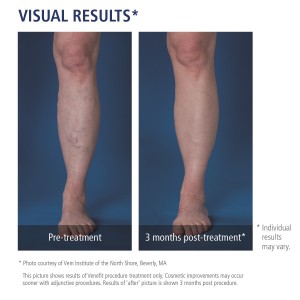What are Varicose Veins?
Varicose veins are a common condition seen in both men and women. They can be red, blue or flesh colored and may be raised above the surface of the skin looking like bulging, knotted cords. These veins are so common (over 30 million people have them) that most people take them for granted and never suspect they can lead to serious medical conditions. Dealing with them is seen as a cosmetic issue, something to be done only for reasons of vanity.
Aren’t Varicose Veins Just a Cosmetic Issue?
Varicose veins if left untreated can lead to a much more serious disease of the venous system known as chronic venous insufficiency (CVI). Symptoms of CVI include pain, swelling, restlessness and fatigue of the legs, as well as skin damage and ulcers in more severe cases. Walking and other everyday activities can become much more difficult in advanced cases.
How are Varicose Veins Related to CVI?
Varicose veins develop when the valves inside the veins of the legs weaken. These valves are designed to keep blood moving back towards the heart. Weak valves allow the blood to flow backward down into lower areas of the legs and feet. The veins stretch to accomodate the extra blood and become more visible. Pregnancy, long periods of time spent standing, and family history of varicose veins are all risk factors for development of varicosities (varicose veins) and CVI. While CVI can develop at any age, it is more commonly seen in older patients. Initial symptoms include a sensation of heaviness in the feet or swollen feet. Changes in coloration of the skin may develop as the condition worsens. Eventually, areas of the leg may develop ulcers due to lack of adequate venous circulation.
Isn’t it Hard and Expensive to Treat Varicose Veins?
Until recently, treatment of advanced cases of varicose veins required surgery and general anesthesia. This approach was more invasive, more painful, and required a longer recovery time. Sometimes a surgical approach is still the better option.
Advances in medical technology have provided other options, however. Using lasers and other minimally invasive techniques, skilled surgeons are able to close off varicose veins and restore more normal circulation for their patients. These minimally invasive procedures reduce discomfort and recovery time, as well as delivering superior results.
With today’s focus on reducing the cost of health care, many insurers offer coverage for treatment of varicose veins as a means of preventing the development of the more serious CVI.
Do You Mean My Insurance Will Pay For This?
In many cases, insurance pays for this medically necessary surgery. Check with your doctor and insurance provider for more information and the steps needed to assure coverage of your treatment.
